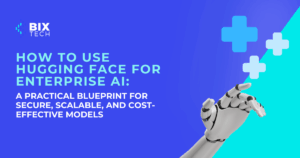Building a Future-Ready Tech Infrastructure: Strategies to Thrive Amid Emerging Trends

Sales Development Representative and excited about connecting people
In today’s dynamic digital landscape, future-proofing your technology infrastructure isn’t a luxury—it’s a necessity. The technology decisions you make now shape your business’s ability to innovate, scale, and adapt in the years to come. Selecting the right tech foundation empowers your team to deliver flexible software solutions that evolve with your business needs, ensuring lasting value and competitiveness.
Let’s dive into why future-proofing matters, the pitfalls of poor infrastructure choices, and practical strategies for building a resilient, scalable, and secure tech stack.
Why Future-Proofing Your Tech Stack Matters
Imagine you and your colleagues launch a promising minimum viable product (MVP). The market responds with enthusiasm, clients are lining up, and your team rapidly expands. But as success builds, so do the challenges: performance bottlenecks, soaring cloud expenses, and unexpected security vulnerabilities. Attempts to fix these issues reveal a deeper problem—your tech stack is outdated, and talent with experience in your chosen tools is hard to find (and expensive).
This scenario, while hypothetical, highlights a common trap. Short-term decisions made for speed or cost-saving often lead to technical debt, security risks, and scalability woes. These issues can undermine even the most promising businesses. To avoid these pitfalls, forward-thinking companies must align technology choices with long-term goals and industry trends.
Key Principles for a Future-Ready Infrastructure
1. Align Tech Choices With Business Objectives
Your technology stack should be selected with both current needs and future ambitions in mind. Startups may prioritize agility and rapid iteration, while established enterprises often need robust compliance, reliability, and scalability. Regardless of size, it’s crucial to account for hidden long-term costs—including maintenance, upgrades, and potential forced migrations.
For a deeper look into the business impact of modern infrastructure, check out our insights on how data science is revolutionizing business and shaping strategic decisions.
2. Choose Technologies With Strong Ecosystems
Prioritize frameworks and platforms that have active developer communities and widespread adoption. This not only eases hiring and upskilling but also ensures ongoing support and innovation. When your tech stack is popular, answers to problems are easier to find, and onboarding new talent is smoother.
Encourage your team to stay current by investing in continuous learning—emerging technologies may come with a learning curve, but early investment pays off in long-term agility.
3. Build for Scalability and Security From Day One
Cloud-native solutions provide a strong foundation for scalability but come with their own challenges. Cloud costs can escalate quickly if not managed strategically, and vendor lock-in can restrict future choices.
Engage FinOps experts to optimize cloud expenses and always prioritize robust security practices—especially if your systems handle sensitive or financial data. Proactive security planning reduces the risk of costly breaches down the line.
4. Plan for Sustainable Maintenance
As your business grows, so does the complexity of your systems. Without regular updates and adherence to best practices, technical debt can spiral, making maintenance unsustainable. Choose modern, actively maintained technologies and enforce processes that keep your stack healthy and efficient.
5. Anticipate the Need for Upgrades and Migrations
Even with meticulous planning, change is inevitable. The best teams prepare for it. Flexible architectures and clear migration paths ensure your business can pivot quickly when market opportunities or new technologies arise. For example, planning for easy cloud provider migration can help you avoid downtime and keep your systems resilient.
Expanding the Scope: Hardware and Infrastructure Evolution
While software stacks get much attention, hardware and overall IT infrastructure play a pivotal role in future-proofing. The rise of virtualization and cloud computing transformed how resources are allocated and scaled. Modern engineering teams now leverage container technologies like Docker and orchestration tools such as Kubernetes for efficient microservices management.
Hybrid and multi-cloud strategies are gaining traction, enabling organizations to balance flexibility, data sovereignty, and vendor risk. By blending private and public clouds, companies can optimize for performance, compliance, and cost.
To explore more on adapting to the evolving cloud landscape, read about navigating cloud migration in 2025 for practical strategies and insights.
Embracing the Next Wave: AI, ML, and Edge Computing
Artificial Intelligence and Machine Learning Integration
AI and machine learning are no longer futuristic—they’re foundational to modern infrastructure. Cloud providers embed AI to automate resource scaling, improve security, streamline administration, and enable predictive analytics. These innovations reduce costs, enhance performance, and provide actionable business insights.
Harnessing AI also strengthens security by identifying anomalies and threats in real time. For practical guidance on leveraging AI in your operations, see our business leader’s guide to AI.
The Shift to Hybrid, Multicloud, and Edge Solutions
Hybrid and multicloud strategies are becoming standard. Gartner predicts that by 2027, up to 90% of organizations will use hybrid cloud setups. Why? Flexibility, better pricing, regulatory compliance, and disaster recovery.
Edge computing is the next frontier, enabling ultra-low-latency data processing for the Internet of Things (IoT) and real-time applications. By moving computation closer to data sources, edge computing supports billions of devices and powers new business models.
Key Takeaways for Future-Proofing Your Technology
- Prioritize alignment between your tech stack and your business’s long-term objectives.
- Select technologies with strong, active communities to ensure support and talent availability.
- Embed scalability and security into your infrastructure from the outset.
- Plan proactively for maintenance, upgrades, and seamless migrations.
- Embrace innovation, including AI and edge computing, to stay ahead of industry shifts.
By making thoughtful, forward-looking technology decisions, your organization will be well-positioned to navigate and lead through tomorrow’s challenges—and opportunities.
Ready to build an infrastructure that thrives amid change? Explore our resources for more on crafting predictive analytics strategies and unlocking smarter business growth with future-ready technology.










